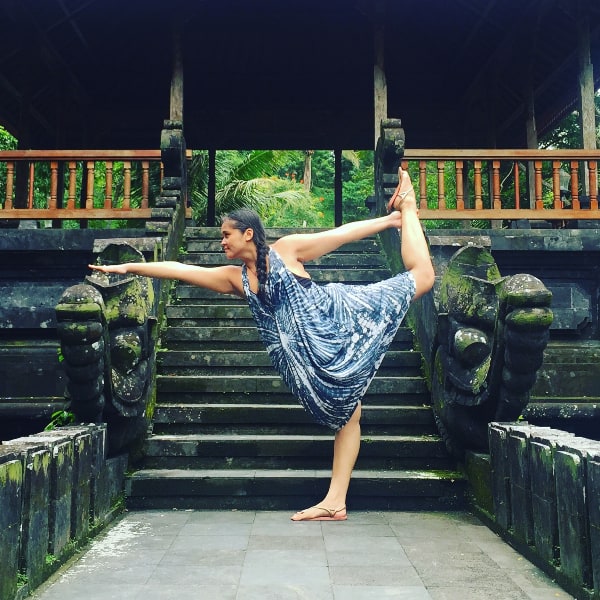This post may contain affiliate links. Please read our disclosure for more info.
When sitting at your desk at work, do you notice that one side of your body may feel more fatigued than the other? Or during your yoga practice, you might feel that your right side is stronger than your left. Regardless of your fitness level or body type, all of us are bound to have some sort of muscular imbalance in the body. Usually, one side of your body is stronger than the other. Or, you may have more flexibility on our right side versus our left side. So how can you help to fix muscle imbalances?

Can yoga help to fix muscle imbalances? Yoga is a very effective tool to help fix muscle imbalances in the body. Practicing different yoga poses builds strength, flexibility, and overall balance in your body. With consistent and regular practice, you will find that you are able to feel more muscular balance in your body.
Is it Normal to Feel Muscle Imbalance?
Ever feel that one side of your body feels overworked and tight? While the other side feels weak and fatigued? The muscles in our bodies control and create movement and when one part of the body is overworked, the other side of the body may feel weak because it isn’t being used as much. This causes muscle imbalance in your body.
It is normal to feel certain imbalances in your body. However, it is important to try to remedy the situation by finding more balance in your muscles. Muscle imbalance can cause injury, pain, and fatigue. The more aware you are of your body and the more in tune you are with the feelings and sensations that occur in your muscles and joints, the easier it will be to find out where the imbalance is.
What Causes Muscle Imbalance?
There are many causes of muscle imbalance ranging from overexertion to particular habits that you may have. While it can be challenging to have your body be completely balanced, it is still important to be aware of muscle imbalance in order to avoid injury and practice healthier habits.
Some causes of muscle imbalance include:
- Holding your phone with your dominant hand: In this day and age, everyone is constantly on their phones. You may spend a good amount of time each day swiping, texting, and gazing down at your phone. Depending on which hand you hold your phone, you may start to notice that your shoulders or neck on one side may start to feel fatigued and tight.
- How you sleep: Are you a consistent right side sleeper or belly sleeper? Staying in one position for a few hours while sleeping can cause muscle imbalance in your body. If you always sleep on your belly and turn your head to the right, try turning your head to the left instead. If you tend to sleep on your left side and shoulder, try to fall asleep on the opposite side.
- Carrying your bag: Do you have a heavy shoulder bag that you always carry on your left side because it feels like your stronger side? It is likely that one of your shoulders may be higher or lower because of this. Try to alternate sides to keep it even in your body.
- Using your dominant side: Whether it’s during your workouts, climbing stairs, writing, or using the computer, you likely have one side that you generally lead with. Be aware of what side you tend to lead with, and make an effort to lead with the opposite side to find more balance in your body.
- Poor posture: If you tend to slouch or round your back, make an effort to find a neutral position with an elongated spine, broad collar, and relaxed shoulders. You may have to train your body, but good posture can go a long way with finding more muscular balance.
- Standing unevenly: Do you tend to rest all of your weight on one side while standing? You might lean more to one side or even tend to lock your knee. These can both cause muscle imbalance. Find a neutral standing position by keeping your knees slightly bent and feeling your weight even on your left and right side.
- Sitting or driving for long periods of time: When you drive, you usually use one side more than the other. In addition, when you are seated for a long period of time, your hip flexors tighten and can cause lower back pain and other imbalances. If you are at a desk for work, make sure that you have good posture and take breaks to move your muscles around.
Does Yoga Help with Muscle Imbalance?
There are many ways that you can work on finding more balance in your body. Yoga is a great way to start to train your muscles to find more strength and flexibility where you need it. Once you are aware of where you feel imbalanced, you can start to feel the imbalance in your body while you practice. With this awareness, you can start to strengthen and open the parts of your body that are imbalanced.
When you practice yoga with proper alignment, you become aware of areas that feel tight or overworked. Similarly, you can feel the areas that feel weak or underworked and start to strengthen what needs to be strengthened.
Practicing Yoga for Muscle Imbalance
As you begin to build a more regular practice, you will begin to become more bodily aware. Whether it’s from your posture or from overuse, you will start to feel the areas that feel imbalanced. With this awareness, you can work on bringing more balance in where you need it.
Make sure that when you practice yoga, you are also aware of the areas in which you may be putting too much strain or effort in your body. For example, if you start to notice that you put more weight on your left wrist than your right, become aware of what you need to do to find proper alignment and balance where needed. Strengthen the muscles that feel weaker than the others. Work on finding stability and flexibility to achieve overall muscular balance.
Top Yoga Poses to Improve Balance
The practice of yoga helps you to become more mindful and aware of what is going on inside your body. Often, there are different poses which can draw attention to muscle imbalance in the body. For example, if it feels more challenging to hold side plank pose on the right side, that likely means that your right side is stronger and more dominant than your left.
With your yoga practice, you can begin to build muscular strength and flexibility where you need it. This will then help you to find more stability and balance in your entire body. The following poses are great poses to practice to find muscle balance:

Ragdoll
This pose allows you to feel where you may hold imbalance in your body. Practice with both of your feet rooted firmly to the ground and your upper body completely relaxed. Does your weight sway to the right? Does your left hip feel tighter than your right? Work on rooting down through both of your heels, engaging your thigh muscles, and releasing and relaxing both of your hips and shoulders.
Mountain
Similar to Ragdoll, notice if you sway to one side or if one shoulder is lower than the other. Find a neutral, elongated spine. Keep your core engaged, legs strong but not locked, and shoulders relaxed.
Tree
It is easy to see which side may be stronger than the other in this posture as you are standing on one leg.
Find stability by lifting up through your kneecap and engaging your thigh muscle. Notice if one hip is lifted higher than the other, and square your hips to find a neutral pelvis.
Eagle
This posture requires balance, flexibility and stability. Because this posture opens up all the major joints in the body, you will be able to notice which shoulder or hip is tighter than the other and which parts of your body need more stability and flexibility. If it is challenging to come into the full pose, work up to it slowly and be patient as you build balance on your left and right side.
Related Questions
How does muscle imbalance cause injury in the body? When one part of our body is overworked or overused, it can cause fatigue in your joints and muscles, which in turn can lead to injury. This is why it is important to be aware of muscle imbalance in the body.
How do I stop falling over when I am in a balancing yoga pose? Instead of looking all around the room, find one spot to focus on. This is called your dristhi. In addition, strengthen and engage your muscles, focus on your breath, and concentrate on the present moment.
How can I modify tree pose? If it is challenging to bring your foot up to your inner thigh or calf, place your foot to your inner ankle and place your toes on the mat like a kickstand. Work on building strength in your muscles and flexibility in your hips.






